
SEOs rely on tools, data, numbers, metrics, reports, charts, graphs, and huge Excel spreadsheets bristling with pivot tables. We do love our data.
But sometimes, the best information comes from the good ol’ eyeball test. One of the best eyeball tests is the Google SERP. Using information from the Google SERP, you can discover how your website is succeeding or failing. This is less about securing rank than it is about discovering a new strategy source.
Why the Google SERP is the SEO’s Friend
Here’s why the Google SERP should not be overlooked as a weapon in the SEO’s arsenal.
- The types of results Google displays tell you what it prefers to return in search results.
- Google provides search results according to a variety of algorithmic factors, but many of these factors are apparent from a cursory look at SERPs.
- Page titles, one of the most essential SEO factors, are easily viewable at a glance from Google’s search results.
- Relevant content that corresponds to the search query is also available at a glance from the search results.
- The more you are able to intuit what kind of results Google displays, the better you’ll become at SEO.
SERP information is the kind of information that delivers powerful knowledge for the SEO. With this information, you can increase the SEO perfection of your site or your client’s site.
1. Identify the Presence of the Keyword or Query String in the Title
Let’s start with title tags, because they are the single on-page element that is most closely correlated with a highly optimized site.
When you type in a keyword, pay close attention to the titles of the sites that are displayed. These titles are critical to the site’s ranking success. If you see your competitor outranking you, understand how the title may function into their ranking.
Keywords in the title are important, but they don’t necessarily trump all other factors. With the rise of semantic search, titles can have a range of keywords, all of which may be a part of the overall ranking of the site.
These results are for the query “iphone 6 phone protector.” Notice how the results feature the keyword “screen protector” instead of “phone protector.” Sometimes, Google decides that it doesn’t quite agree with your keyword, so they will deliver results that are a little bit different. This is important information to know.
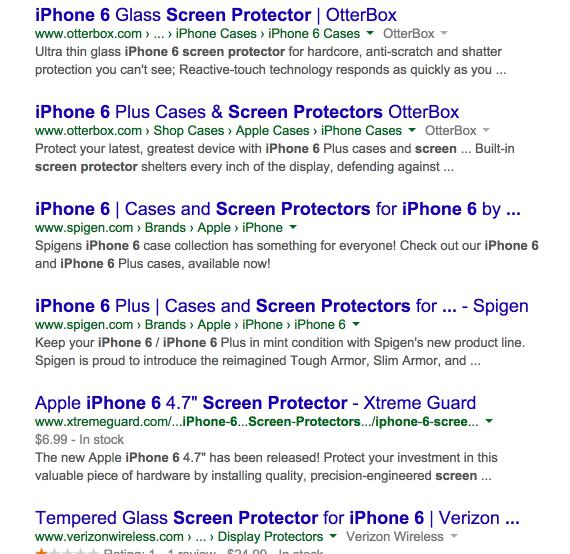
2. Pay Attention to the Significance of Keywords in the URL
It’s obvious that URLs are important for SEO and search results. If your competitor is outranking you for a given keyword, figure out what they are doing with their URL.
Ask the following:
- Does the URL of their page have any of the keywords in the query?
- Does the URL of your page lack the keywords in the query?
If the answer to both questions is yes, then you may have identified an area of opportunity. You may wish to create a page with a URL that contains some of the target keywords.
Here’s an example. The keyword “video ad monetization platform” has the following top two results.

Notice several significant things about these results.
First, Brightcove’s page has the following words in its URL: “video, platform, advertising, and monetization,” all of which correspond semantically to the query.
https://www.brightcove.com/en/online-video-platform/advertising-and-monetization
By contrast, SpotXChange’s page has a URL with none of the keywords.
www.spotxchange.com/publishers
Again, there are a lot of factors at play here. It’s impossible to make a definitive case for URL being the only algorithmic influence that has produced the higher ranking from BrightCove. But we must at least admit that it has some level of influence. Furthermore, we have to acknowledge that if SpotXChange were to produce a similar page with closer URL relevance, it might achieve higher ranking.
3. Understand What Kind of Results are Favored in the Search Results
All types of content are not created equal, and Google doesn’t treat all content as equal when they deliver it up in the search results.
When you type in your query, find out exactly what kind of content seems to be ranking best. This could be your clue as to which kind of content you need to be generating.
The type of query is the most significant factor in determining what kind of results will get returned. Obviously, if someone types in “infographic” or “video,” Google knows to deliver infographics or videos. But some of the fuzzier queries are less obvious. These “fuzzy” queries are what you need to be focusing on. Here are some examples:
- “best type of ____.”
- “how to use ____”
- “ratings for ____”
- “reviews of ____”
What kind of results will those queries get? It depends, but here are some of the possibilities:
- “best type of ____” — sponsored ads, in-depth review articles, customer rating sites
- “how to use ____” — markup, detailed articles, videos
- “ratings for ____” — articles on review sites, customer ratings
- “reviews of ____” — User generated content, highly informative blog posts
I’ll use the query “how to use a bluetooth headset” as an example. Here’s what I get.
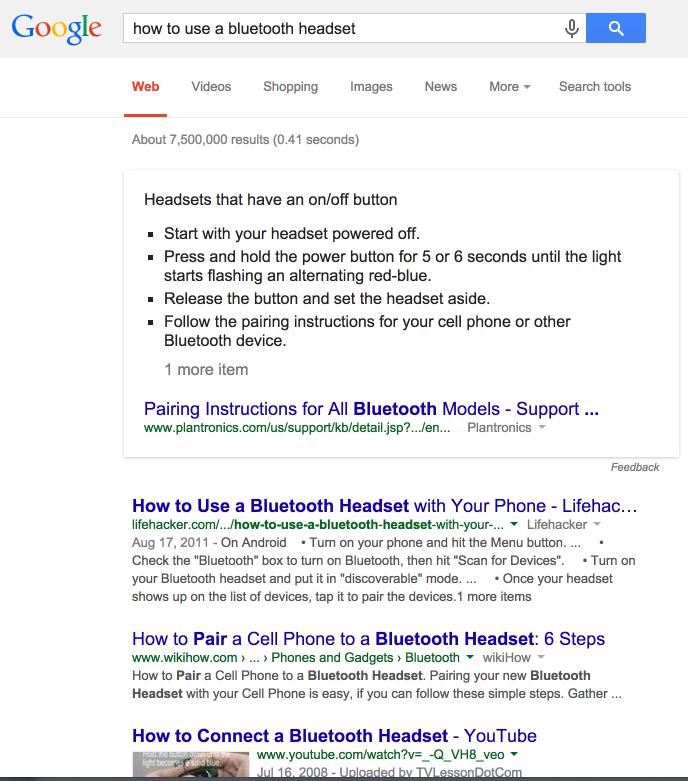
This could be a bit of a surprise. There’s nothing branded about that query at all, but a brand Plantronics, takes the SERP cake, because they have powerful content that corresponds to the query.
Let’s look at another example: “reviews of jawbone era.”
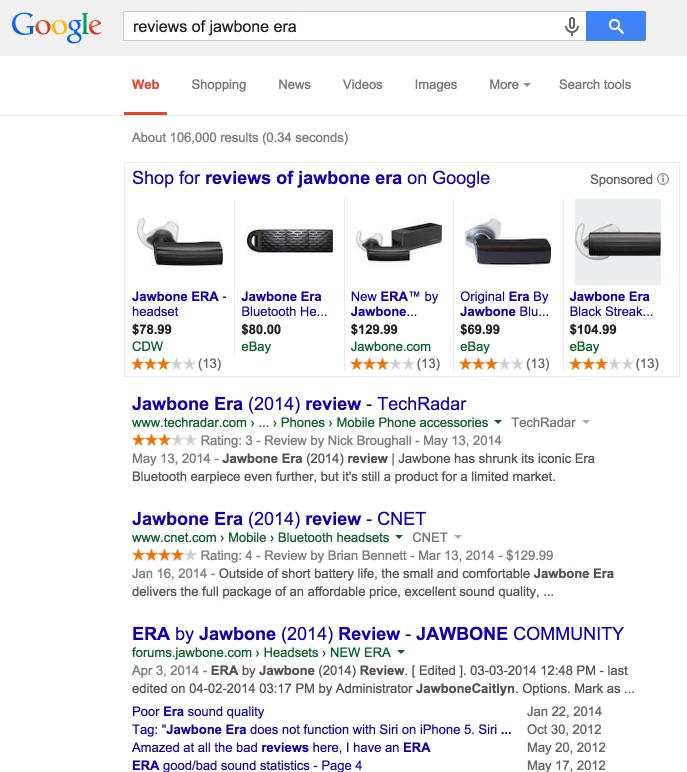
There are a few notable features about this SERP regarding the type of content that is being delivered:
- First, there are plenty of sponsored ads. No surprise there.
- Second, the top two results are not on the jawbone site. They are on review sites. This is a testament to the power of detailed articles.
- Third, the top results from Jawbone aren’t product pages at all. It’s user-generated content! This indicates two things. First, Jawbone needs better product pages with more and higher quality content. Second, Jawbone is doing a great job with UGC. Their forum site is getting third-position results for “reviews of jawbone era.”
When you dive into a SERP with an eye to the type of content being displayed, it can powerfully inform your content marketing efforts.
4. Observe How Keywords are Distributed in the Title, Description and/or Content
This may be surprising to a lot of SEOs, especially those who haven’t kept pace with the rapid development of semantic search.
We all know that longtail keywords are significant. We know, also, that keyword intent is significant. But how does this all look like when Google chews up the query and spits out results?
It looks like we’ve lost the longtail keyword!
In this result, I searched for “title tag keyword implementation”. The search results have no occurrence of that specific long tail keyword. None.
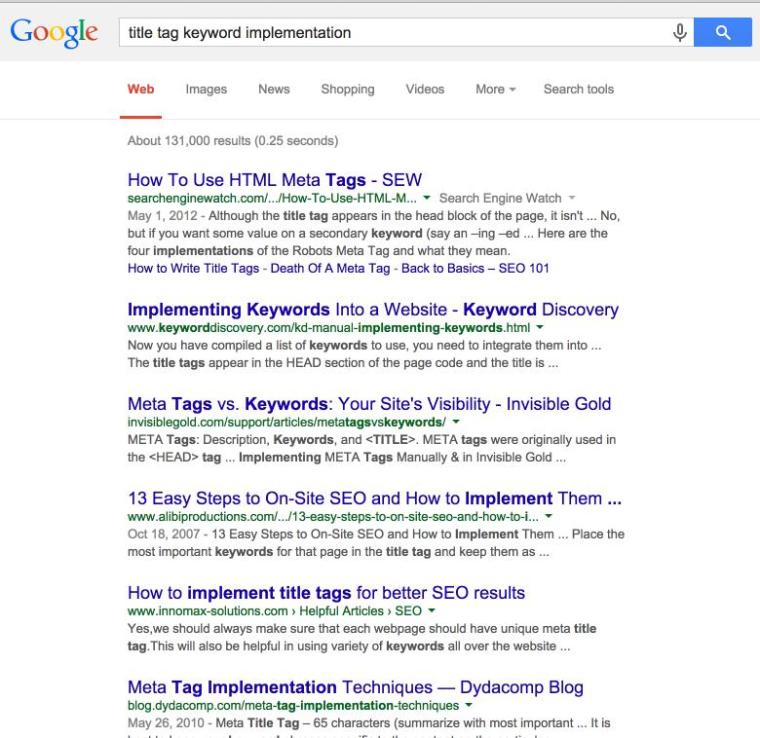
What do we have then?
We have a mashup of every conceivable combination of that query. All the words are still there. They’ve just been moved around, swapped, traded, synonymized, and altogether changed.
“Title” is present as a keyword, along with “title tag”.
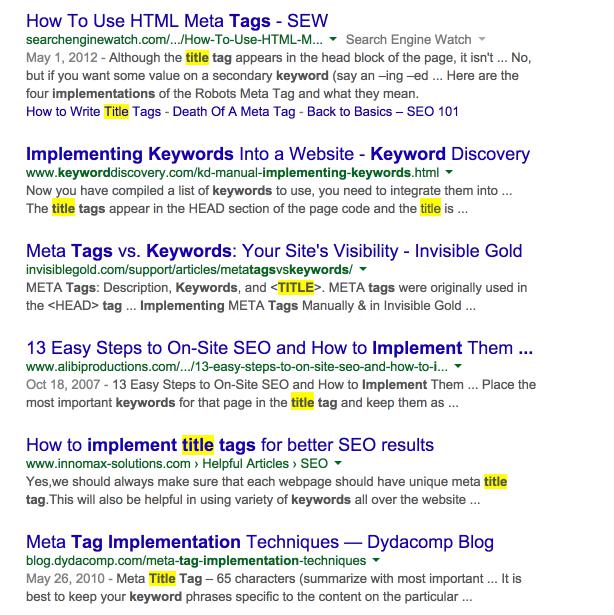
“Tag” is present, but it’s sometimes paired with “meta” instead of “title.”
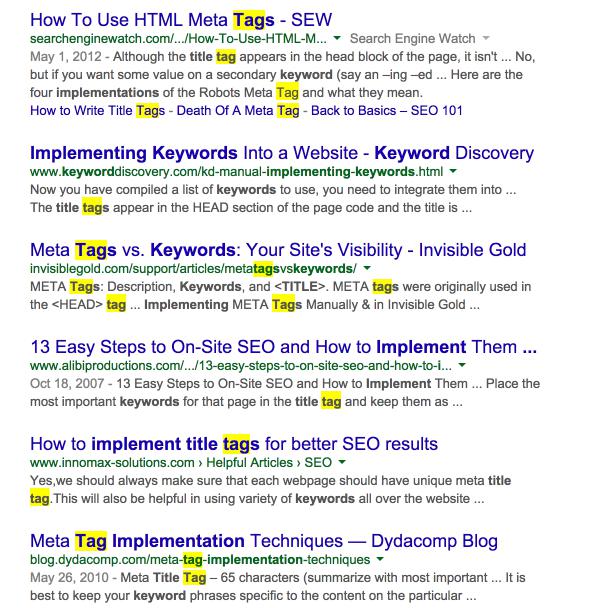
“Keyword” is there.
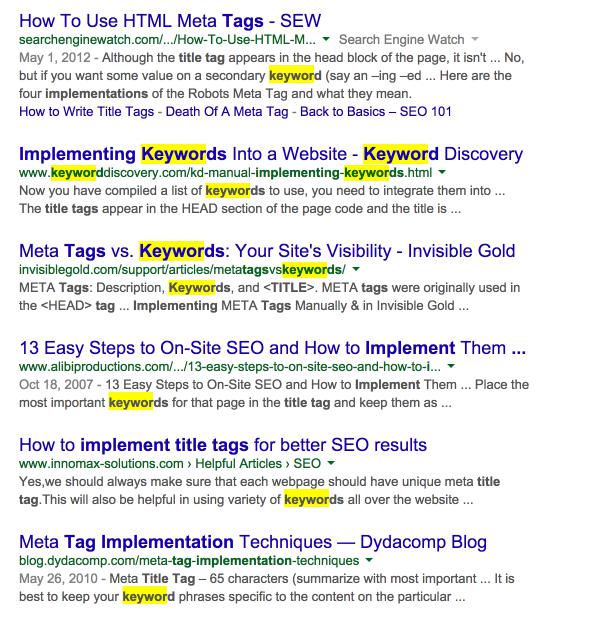
The word “implement” is present, too. It appears as “implementations,” “implementing,” “implement,” and “implementation.”
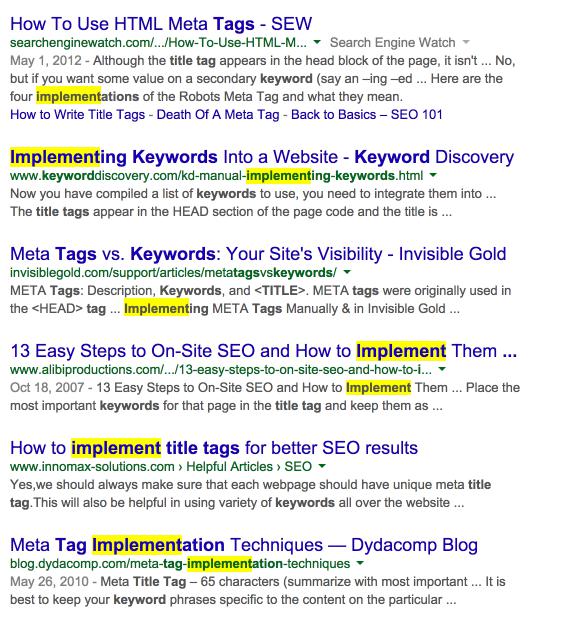
Results for your particular keyword, of course, may vary. The important thing is to be aware of how keywords are appearing in the various areas of the SERP — title, URL, description, and content.
5. Whether Sites are Using Structured Data or Not
If the competitor sites have no structured data, it’s a clear sign that you have an opportunity to outrank them.
And, according to the data, not many domains have Schema integration.
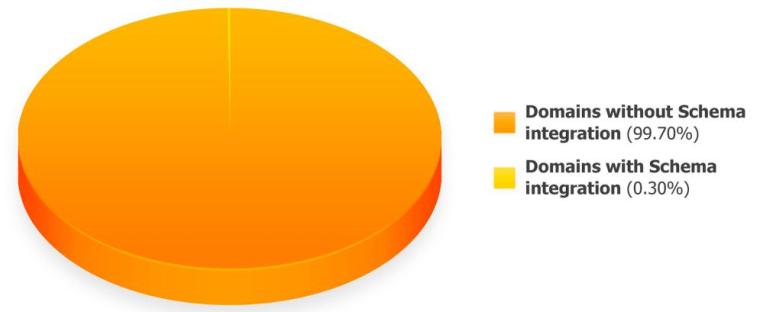
On the other hand, if your competitors are using Schema, it’s a pretty strong indication that you should do the same.
Here’s an example. Little Tikes, the makers of the “Cozy Coupe” toy car have the rank advantage for the “Cozy Coupe car” keyword. They may not, however, have the CTR advantage. Why? Because their SERP entry lacks the structured data present on the Toys ‘R Us entry.

Here’s why. Google obviously prefers to rank sites with schema markup. According to the jaw-dropping study from Searchmetrics in early 2014, the search community found out that pages with Schema markup ranked four positions higher in the search results.
Whether the schema causes the higher rank or not is still a matter of conjecture, but the correlation is obviously there. Even if Schema doesn’t produce rank, it can at least enhance a SERP entry.
“But my site is different. There’s no data that I need to markup.”
This is one of the most common objections to the use of markup. There’s a mistaken notion that many of the Schema implementation is only relevant for movies, offers, TV series, reviews, or product pricing.
Schema is for much more. Check out the full list of Schema types available. Does your business have a name? Alright then; you can use Schema.
A word of caution is in order. Google recommends against the use of rich snippets on your homepage. Every other page on your website? Go for it. Homepage? Not so much.
6. Get a Feel for the Descriptions
Most SEOs will tell you that the description doesn’t matter for SEO. That’s only partially true.
Descriptions matter very much for SEO, because they…
- Affect clickthroughs…
- And clickthroughs affect search results.
It’s highly likely that Google uses CTR to rank sites in the SERPs.
So, what has the greatest effect on clickthroughs?
Descriptions.
Descriptions are the secret sauce to many high-ranking pages. Sites with very appealing, powerful, relevant, and readable descriptions tend to rank higher. The likely reason for this is that they have higher CTRs, which eventuated in higher SERP ranking.
As you peruse the descriptions, take a look at top ranked sites. In addition, simply get a feel for how each description affects you. Is it appealing? Relevant? Powerful?
Take a look at these two descriptions. Which one would you click on?
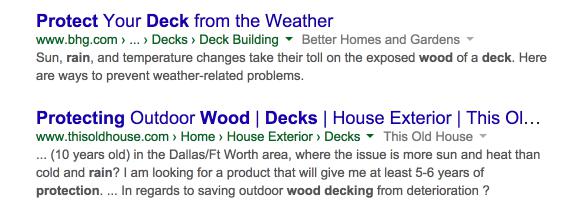
If you live in the Dallas/Ft. Worth area, you might be interested in the second one. However, the first result from BHG.com has greater appeal, simply because it’s complete. It has two sentences, not several fragments and ellipsis.
The quality of your description has an effect on your CTRs, which in turn has an effect on your SEO as a whole. How you write them matters.
Conclusion
When was the last time you looked at the SERPs for your target keywords? If it’s been a while, this is one of the easiest eyeball tests you can do. There is a ton to learn.
Give it try. Google your target keyword, and see what comes up. Figure out what the top ranking sites are doing, and copy them.
[“source-searchenginejournal”]


